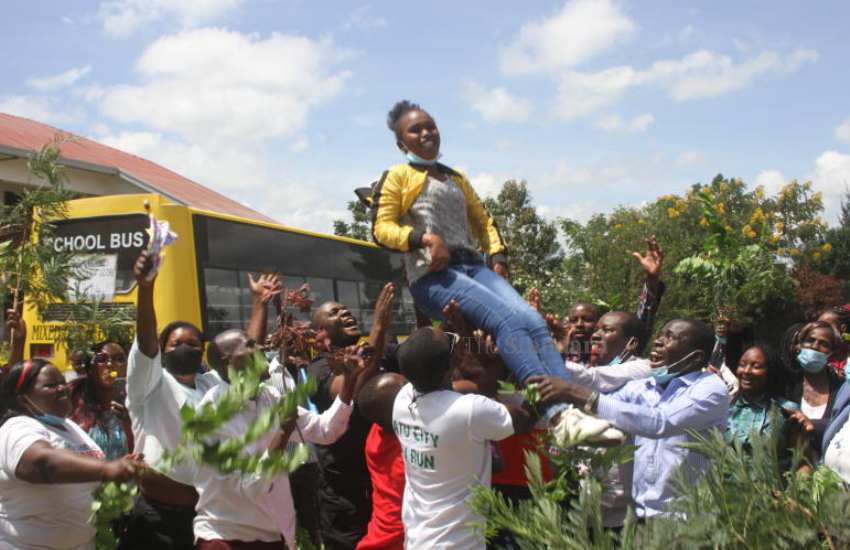Top Ministry of Education officials are meeting to fine-tune selection guidelines that will be used to place students in Form One this year.
The Standard has established that a multi-sectoral team has retreated to Naivasha to craft a formula that will be used to place KCPE candidates in secondary schools.
The officials in the team are often drawn from the directorate of secondary education led by Paul Kibet, quality assurance staff and some from the Department of ICT.
In some cases, the Kenya National Examination Council (Knec) is represented alongside other State agencies to ensure the selection process is water-tight.
Education Cabinet Secretary George Magoha said during the release of the 2020 KCPE results that all the 1,179,192 candidates who sat KCPE examinations will be admitted to secondary schools under the government’s 100 per cent transition policy.
He said Form One selection shall be done on May 28 and the students are expected to join secondary schools in July.
Between now and Friday, next week, the team is expected to analyse the available capacities in national, extra-county, county and sub-county schools ahead of the placement scheduled for next week Friday.
Data from the ministry shows that there are 29,712 slots in all the 103 national schools.
Another 123,400 spaces are available in 531 extra-county schools and 142,358 slots in 1,031 county schools.
Sub-county schools – the day schools – have a capacity of 685,590 in all the 7,325 institutions.
There are also some 35 Special Needs Education (SNE) secondary schools with a capacity of about 1,500 slots, according to ministry data. These are boarding institutions that cater for students with special education needs.
![]()

Their catchment is national and selection is done based on merit, candidate’s choice and type of impairment.
Pre-selection for SNEs Starehe Boys and Starehe Girls, Moi Forces Academy (Nairobi and Lanet), Utumishi Academy and Moi Tea Girls is done separately.
Parents biggest worry, however, rests in the other categories – national, extra-county, county and sub-county schools.
The team is expected to make fresh calculations of available capacities and candidature per sub-county, which will be used during selection and placement of students to national schools.
The Standard, however, established that Form One selection formula that had been used in the previous years will still be in force for this year’s candidates.
The formula considers merit, candidates’ choices and affirmative action among other parameters.
This means that enrollment to national schools may not be pegged on higher scores in KCPE examinations only.
Other factors such as regional balance based on sub-county performance will also determine the placement.
The formula guarantees all students who score 400 marks get slots in national schools.
In last year’s KCPE, only 8,091 candidates attained the 400 marks grade, against the available capacity of 30,000 spaces.

National Parents’ Association chairman Nicholas Maiyo said parents are worried that only a small number of candidates scored 400 and above and pleaded with the ministry to open national schools to accommodate up to 370 marks.
This means that there will be a scramble for the remaining 22,000 slots in the national schools for candidates with higher grades outside the 400 marks bracket.
According to the 2020 KCPE Knec data, 282,090 candidates scored between 300 and 399 marks, giving many parents hopes of landing a chance in national schools.
If the quota system used over the years is employed, it will ensure that candidates who scored fewer marks but emerged top performers in their sub-counties may land slots in the coveted schools when placement kicks off.
Based on the quota, a number of top candidates per sub-county are picked for admission to national schools.
The good news, however, is that students who will not get slots in the national schools will get places in 531 extra-county schools. These are boarding schools that are the second-tier national centres of educational excellence.
These schools complement national schools in promoting integration and bench-marking education standards in their regions.
The selection formula for extra-county schools is based on a 20:40:40 ratio. This means that 20 per cent of the candidates admitted to these schools must come from the host sub-county. The host county and other counties should be represented at a ratio of 40 per cent each.
And candidates who will miss out on extra-county schools will be admitted to the 1,031 county schools.
These are boarding secondary schools in the host county other than national or extra-county schools.
They are the former provincial boarding schools that admit from the host county and based on the districts’ KCPE candidature.

Admissions to county schools are based on a 20:80 ratio. This means that the slots are shared out between the host sub-county and the rest of the sub-counties.
The majority of the candidates will however be enrolled in the 7,325 sub-county schools, which have a capacity of 685,590 spaces.
The government is presently implementing a new directive that requires all children in sub-county (secondary day) schools to enrol in the nearby high schools where they can easily commute daily.
This is a marked departure from previous practice where some students in day schools are enrolled in institutions far away from their homes, posing huge transport challenges.
Credit: Source link